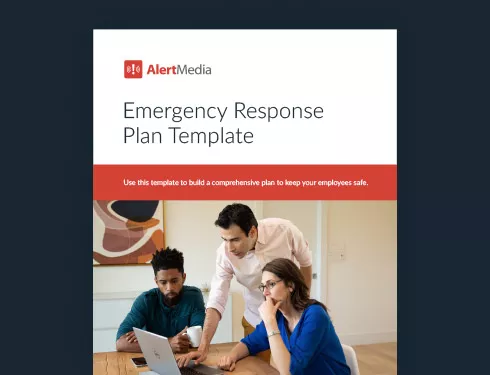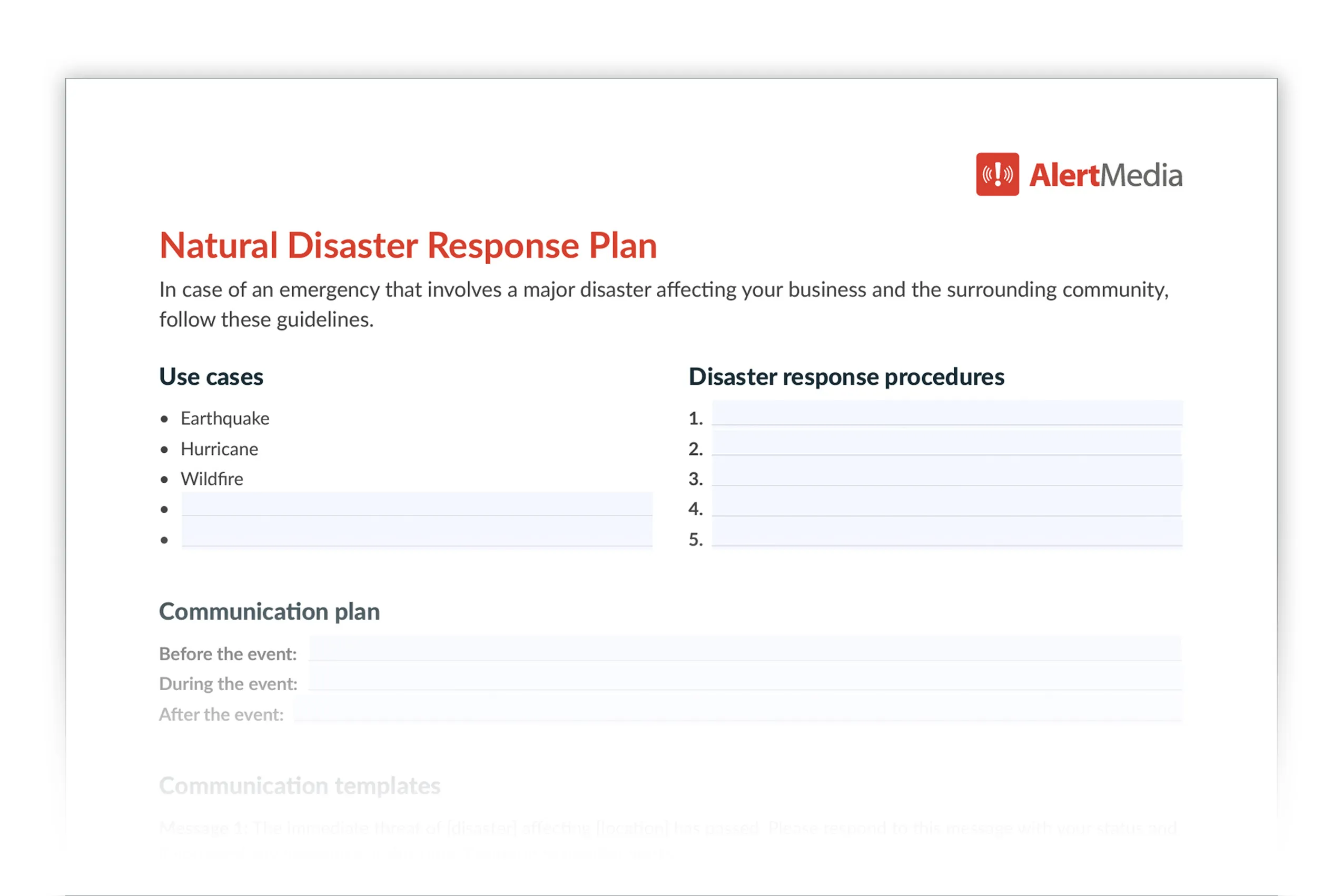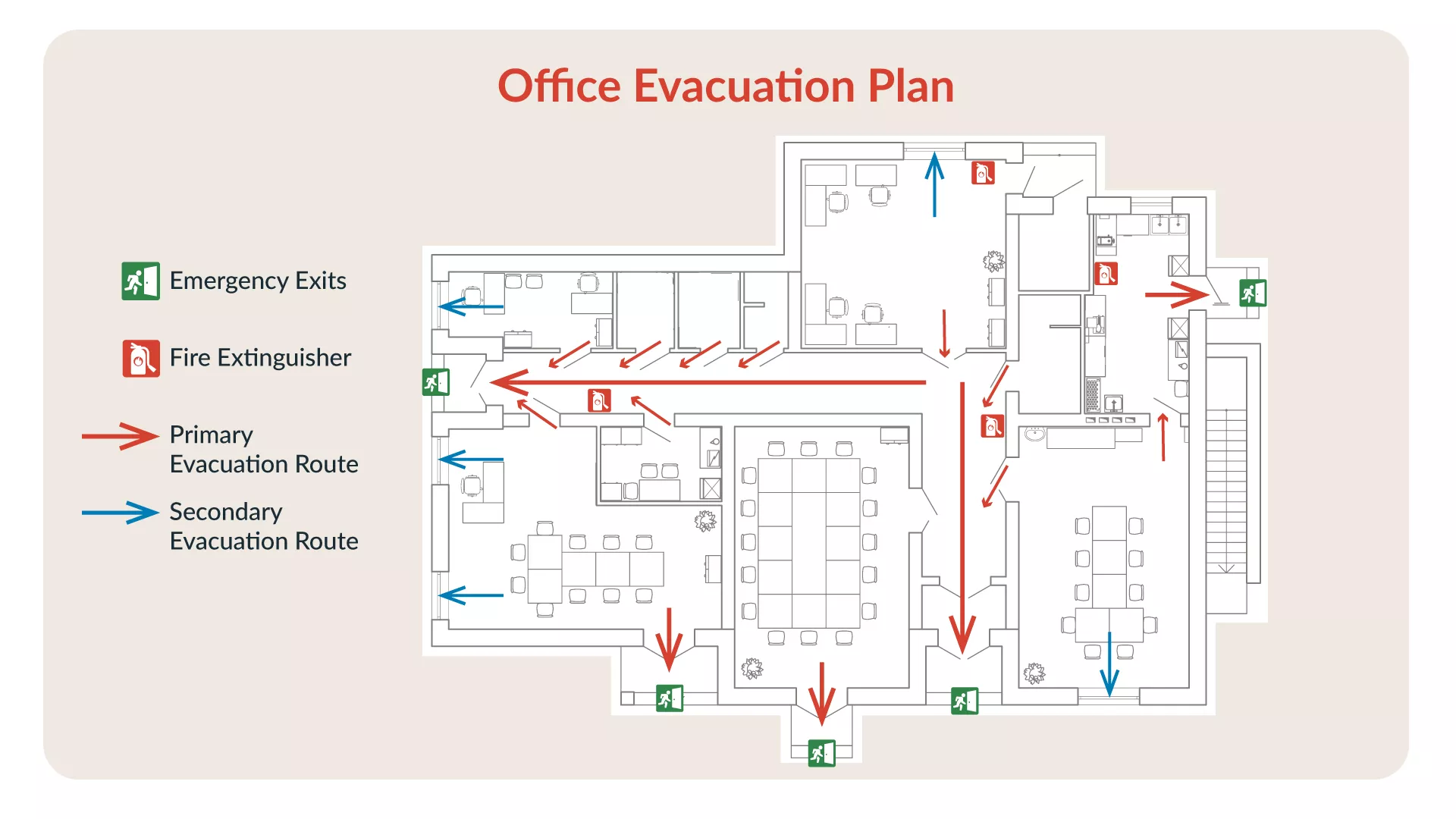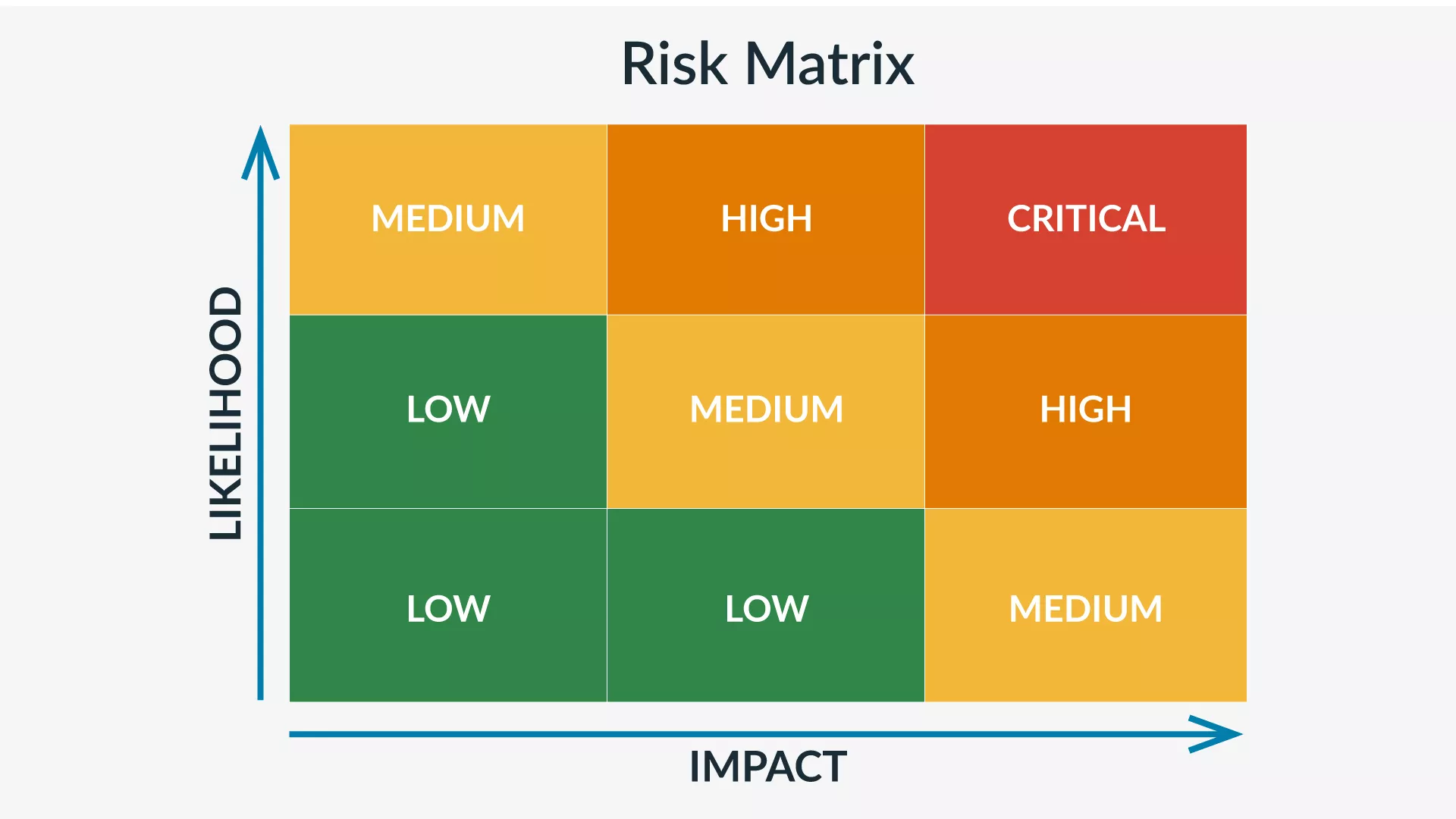
How to Create an Emergency Action Plan in 6 Steps (+Template)
Emergencies rarely announce themselves before people’s safety is on the line. Keep your company safe and ready with an emergency action plan.

When a fire sparks, the power goes out, or a chemical spills, it’s a safety leader’s first priority to get everyone to safety and keep others out of harm’s way. However, our Employee Safety Report shows that only 38% of working Americans strongly agree that they’d know what to do in the event of an emergency at work—which leaves 62% of employees hesitating, guessing, or outright not reacting to crisis situations.
If you don’t already have an emergency action plan in place, now is the time to formulate the best possible crisis response procedures and train your people to be ready. It’s an ongoing, iterative process, but we have some clear steps to get things started.
Download Our Emergency Response Plan Template

A preview of our template to document your emergency action plan
What Is an Emergency Action Plan?
An emergency action plan, or EAP, is a document outlining the actions employees and employers must take in the event of an emergency to protect people and save lives. This plan usually includes parts of other familiar emergency planning practices, such as threat assessments and evacuation routing.
The emergency action plan is not concerned with business continuity or loss prevention directly; it is intended to protect human life, health, and safety. This post outlines ways to keep your people informed of dangers and ways to avoid them. While there are trained leaders and coordinators involved who will facilitate the execution of the plan, each employee needs to know what is expected of them to avoid confusion when faced with an actual emergency.
Does Your Business Need an Emergency Action Plan?
Yes! It is always a good idea to have emergency action plans in place to ensure there is a safe way to respond to any given situation. In fact, the Occupational Safety and Health Administration (OSHA) requires that all businesses with 10 employees or more have an emergency action plan (section 1910.38 of 29 CFR) documented in an accessible location. Different organizations are bound to face different threats. And even those that share potential threats might anticipate different likelihoods or levels of impact on safety. Emergency preparedness is a customized, fine-tuned process that continues to improve, making your business safer and more resilient.
Different organizations are bound to face different threats. And even those that share potential threats might anticipate different likelihoods or levels of impact on safety. Emergency preparedness is a customized, fine-tuned process that continues to improve, making your business safer and more resilient.
Elements of an Emergency Action Plan
All emergency plans are going to be unique depending on a wide range of factors, but they should cover each of the following to ensure people’s safety.
Types of emergencies
While you don’t need a plan for every little incident, focus carefully on risks that have the potential to harm your employees physically. Start your planning with a thoughtful assessment of the potential threats to your employees’ safety.
For example, virtually every company has to prepare for the risk of a fire emergency since they are known to spark in just about any location and are by far the most common workplace emergency. However, if your company is an accounting office, you don’t have to worry about hazardous materials accidents like some manufacturing facilities would.
Use your best judgment when determining which scenarios warrant an emergency action plan of their own.
Specified roles and responsibilities
When disaster strikes, people need to know what to do and when. Most of your employees will be tasked only with following the approved exit routes and meeting at the appointed rally spot. Others will have designated responsibilities related to communications systems, directing evacuees, or making quick decisions when an original action plan is no longer a safe option. Your plan must have contact information for employees responsible for critical emergency action steps.
Emergency action plans are designed to get your people to safety, not necessarily to fix the problem that caused the emergency. For example, it’s up to the authorities to handle an active shooter, and it’s up to the electric company to restore power to the grid. Your priority with these plans is to keep everyone safe. The secondary objective is to clear the way for emergency responders to get on-site.
Emergency procedures
This is the most straightforward part of your plan, and you might already have evacuation routes drawn up for things like fires. Below, you can find an example of a fire evacuation plan for a hypothetical office. Keep in mind that you can also make note of related resources such as fire extinguishers and first aid kits to keep that information accessible to everyone.

Not all evacuation plans are interchangeable. For example, the path you would take to escape a fire would be different from one intended to avoid an active shooter. Don’t rely on just one escape pattern to cover all possible scenarios; just like with the rest of your plan, analyze and determine evacuation routes based on the circumstances.
Training
No matter how well-written your emergency action plan is, if nobody’s familiar with it by the time of an actual emergency—in effect, you don’t have a plan. Different emergencies often require very different response procedures. Even different types of severe weather: A tornado calls for a shelter-in-place response, and a hurricane calls for an evacuation. Reviewing procedures for likely scenarios is the only way to ensure employees—from new employees to safety leaders—will be prepared.
Train everyone on what is expected of them, even if it’s just following an evacuation route. Depending on the structure of your company, decide whether it’s most effective to train individuals, groups, or the entire company at once. Make this training hands-on to give your people the necessary experience to stay calm when they’re asked to perform these functions during a real crisis.
Alerting staff and visitors
When a condition triggers one of your emergency action plans, you need to have a parallel emergency communication plan to broadcast that message to everyone. Public announcement speaker systems, alarms, and mass notification systems are all great ways to get everyone’s attention quickly and reliably.
Reporting to authorities and media
Many emergencies, such as fires, active shooters, and gas leaks, require authority intervention and emergency personnel. Don’t take for granted that someone will have the presence of mind to call 911. Incorporate that step into your plans to ensure it gets done.
When something big and unexpected happens, people naturally have questions. It’s up to you and your team to control the narrative and preempt any misinformation before it spreads. If the emergency you’re planning for might impact the greater community or your brand reputation, include steps to reach out to the media and inform them of the situation so they can help you disseminate the message.
Emergency reporting supports the response efforts in real-time, and it also helps to improve future responses by clarifying events during after-action reviews.
6 Emergency Action Plan Steps
You can approach a range of emergencies in a similar way. Our emergency response plan template can help you cover every aspect of an emergency action plan in one document to share throughout the organization. It even has sample procedures for a variety of incidents to help get your ideas flowing.
Here are the steps you’ll need to take to create a comprehensive emergency action plan:
1. Assess risks
Preparedness is only possible once you understand the risks at hand. Begin with a threat assessment to identify the range of possible threats to your people’s safety and analyze the likelihood and severity of each. This process requires you to take a close look at your critical operations, facilities, people, and external conditions. For an emergency action plan, you’re interested in physically threatening emergency situations.
Once you have an idea of what these threats are, you can quantify their potential risk. In this case, risk is defined as a combination of an emergency’s severity/impact and frequency/likelihood. Plot these two variables in a “threat matrix” to visualize which threats are most significant and which to plan for first.

Here are some examples of emergencies you might plan for:
- Fire
- Bomb threat
- Active shooter
- Natural disaster
- Power outage
- Protests/civil unrest
- Medical emergency
- Chemical leak
2. Research relevant regulations
Depending on your location, your plan might be subject to government regulations. In all U.S. States, OSHA is the primary agency setting rules to keep workers safe. Keep in mind there might also be local or state laws to comply with.
OSHA requirements for an emergency action plan
OSHA section 1910.38 (29 CFR) requires all businesses to have an emergency action plan. Here are the specific things OSHA wants each EAP to include. Note that this should NOT be considered an exhaustive list; you need to develop a plan that is tailored to your workspace, employees, and expected emergency situations.
- Procedures…
- For reporting a fire or other emergency
- For emergency evacuation
- To be followed by employees who remain to operate critical plant operations
- To account for all employees after evacuation
- To be followed by employees performing rescue or medical duties
- Identification of go-to people for EAP questions
- Ensure you have an alarm system, including a fire alarm
- Train employees
- Review and update once per year
- Keep the written document in an accessible location if the company has at least 10 employees
Once you’ve completed your plan, you can use this handy eTool to ensure compliance with OSHA standards.
3. Manage response plans
Many of your response plans will require evacuation procedures. To create those, find a scale-accurate map of your office or workspace. On this map, mark the following:
- Emergency exits
- Fire extinguishers
- First aid kits
- Arrows designating evac routes to the nearest exits
- Designated assembly areas outside of the building
Once you have that map marked up, make copies and post them around the office in highly visible locations. From there, ensure all equipment is stocked up and evacuation paths remain free of obstructions and tripping/slipping hazards. These paths need to be wide enough to accommodate your employee headcount.
You might want to assign official “hall monitor” roles to some of your employees. Those individuals will be empowered to move misplaced stuff out of important walkways to keep them safe and clear.
Depending on your workspace, you might task some employees with unique responsibilities to help keep people safe. These emergency coordinators might stay behind for a period of time to accomplish these tasks, including
- Being a point of contact to answer questions about the plan
- Turning off gas and/or power while evacuating
- Helping those with movement disabilities get to safety
- Performing a head count at the assembly point to account for any lost people
It’s important to note that not all emergencies will require evacuation. Certain emergencies, such as tornadoes and some biological hazards, are best dealt with by sheltering in place. Regardless, the process of preparing for that is very similar to that of an evacuation, but instead of gathering at a point outside the building, you’re gathering in interior rooms.
4. Evaluate resources and tools
As you develop emergency action plans for different situations, list the emergency equipment and resources your team will need to stay safe and secure. You might already have some of the necessary supplies, so take stock and identify the gaps in your readiness for emergency plans.
These tools can include fire extinguishers, automatic fire suppression systems, escape ladders, smoke-blocking masks, other PPE, and much more. Resources can also come in the form of employee knowledge, such as first aid training or even search and rescue experience.
Resources can also include emergency contacts and first responders, such as the fire department, law enforcement, and emergency medical services. Be sure to have emergency numbers clearly documented and accessible at a moment’s notice.
5. Document the plan and update it
Here’s where the rubber meets the road—or rather, where the pen meets the paper. You now know what emergencies might sneak up on your organization, and you also know how to handle them in a way that keeps everyone safe. It’s time to capture them in a clear and accessible way.
As mentioned above, our own template provides a fillable format for this information, so you just have to plug in your organization’s details. As long as you include everything needed for a safe and effective response, your emergency action plan format can be whatever you and your people find most intuitive. Once you have these details documented, introduce the plan to all current employees, and familiarize all new hires with it as part of their onboarding process.
Much like how a business changes over time, emergency management must also evolve. Review your plans at least once per year to make sure they’re still applicable and create new ones if your business moves to a new location or undergoes a renovation—or whenever a new potential threat emerges. It’s also best practice to review the plans with all employees whenever the entire plan changes or with certain groups if a section changes that impacts them.
6. Train and prepare
Now you’ve identified the risks, planned your response, and shared it with your team. The final step before implementation is employee training.
As most of your action plans will be centered around evacuating, it’s essential that everyone is familiar with that process so it can go smoothly if you have to put it into action. Run quarterly drills for the entire company to simulate evacuations that correspond to your team’s potential threats.
Pro Tip: Check out our blog on running a fire drill for more tips on evacuation training.
Additionally, identified leaders and coordinators need to practice their assigned responsibilities, such as helping a disabled colleague or guiding evacuating people along escape routes. This practice helps them get used to handling an independent task in the midst of an emergency.
Finally, if you have specialized equipment unfamiliar to your people, such as respirators or fire escape ladders, organize sessions for everyone to get hands-on experience so they know how to use them during a critical scenario. Likewise, you can train for scenarios that may call for a different response.
Spring Into Action
When your company is staring down an emergency, it’s past time for planning. Once you identify a disaster, you need to be able to take action—quickly, confidently, and comprehensively—to keep everyone safe. The procedures you have developed will give everyone at the company a clear understanding of what to do in a chaotic situation. Your emergency action plan will be that guiding light to lead everyone to safety when disaster strikes. Even if you’re feeling overwhelmed by the idea of getting started, our template serves as a step-by-step guide to bring you closer to preparedness.

![9 Steps to Creating an Effective Emergency Response Plan [+ Template]](https://www.alertmedia.com/wp-content/uploads/2023/10/Blog-Emergency-Response-Plan.webp)
![How to Create an Emergency Evacuation Plan [+ Template]](https://www.alertmedia.com/wp-content/uploads/2022/12/Blog-Image-Emergency-Evacuation-Plan.jpg)
![Disaster and Emergency Communication Plan—5 Steps [+Template]](https://www.alertmedia.com/wp-content/uploads/2022/03/BLOG-Emergency-Communications-Plan-V1.jpg)
